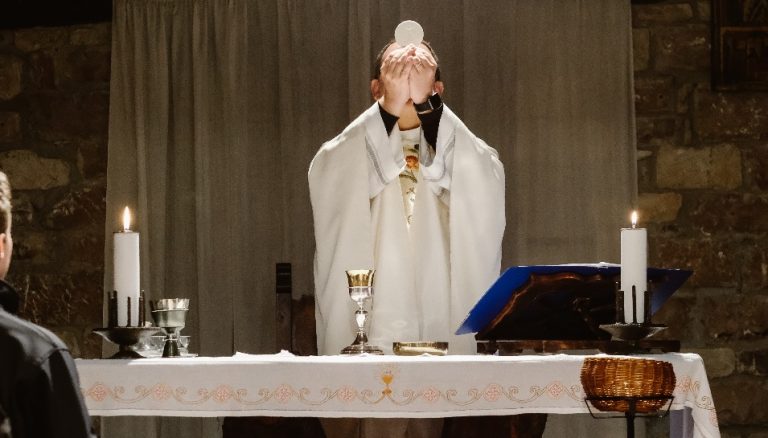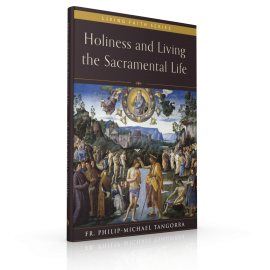By Philip-Michael Tangorra
Fr. Philip-Michael Tangorra is the author of Holiness and Living the Sacramental Life from Emmaus Road Publishing.

In order to convey the mysteries of our salvation, the sacred liturgy uses signs and symbols which are visible revelations of the invisible realities of the mysteries which are being experienced and presented to us. The art, architecture, music, and linguistic poetics of the Mass are meant to raise the congregation in a united heart and mind of praise, worship, honor, and glory given to God. In order for these concrete signs, which include the gestures and movements of the sacred ministers and the vestments and sacred vessels used, to “lift up our hearts,” they must be beautiful, in order to inspire awe in the presence of the love, light, and majesty of God.
Our appetibile sense is engaged by beauty, and so we are led to the source of beauty, which is God. The signs of the sacred liturgy affect our communion with God in love and holiness, as Pope Benedict XVI states: “As Saint Bonaventure would say, in Jesus we contemplate beauty and splendor at their source. This is no mere aestheticism, but the concrete way in which the truth of God’s love in Christ encounters us, attracts us and delights us, enabling us to emerge from ourselves and drawing us towards our true vocation, which is love.” The beauty of the liturgy is one of these visible revelations of the signs, Pope Benedict XVI continues, which bring us into the mystery of the Trinity, as God himself is beautiful.
The sacraments are visible signs of God’s presence among us, and they radiate the beauty and glory of God. The revelation of God’s love attracts us and draws us into a mimetic desire for the majesty of God; this desire is what leads us to put into practice in our lives the realities conveyed in the sacred signs of the liturgy. The sacramental signs draw human experience and actions to their glorified fulfillment, which is only possible in the beauty of divine love.
The actions of Christ in the sacred liturgy take up human acts common to all cultures in order to draw all into union with him. The Church expresses the inexpressible through simple, everyday things, such as water, bread, wine, oil, and salt. As the Catechism states, “Inasmuch as they are creatures, these perceptible realities can become means of expressing the action of God who sanctifies men and the action of men who offer worship to God. The same is true of signs and symbols taken from the social life of man: washing and anointing, breaking bread and sharing the cup can express the sanctifying presence of God and man’s gratitude toward his Creator.” These sacred signs are recognizable to all people, so through these universal and everyday sacramental signs, Jesus can be perceived and understood by all humanity.
The bread, which is a combination of many grains, symbolizes the great multitude of humanity who come to offer themselves in the sacrifice of the New and Eternal Covenant in Christ. In the Eucharist we renew our participation in the New Covenant, as the prayer states: “Take this, all of you, and drink from it, for this is the Chalice of my Blood, the Blood of the New and Eternal Covenant, which will be poured out for you and for many for the forgiveness of sins.” A covenant is always sealed in blood, hence we see the animal sacrifices of the Hebrew Covenant, and especially that of the sin offering of the lamb (See Lev 4:32, 14:13, and 14:24), as prefigurations of the sacrifice of the New Covenant in Christ, the unblemished Lamb. The Catechism points out the many ways the coming of Christ was foretold throughout the Old Testament: “Among these liturgical signs from the Old Covenant are circumcision, anointing and consecration of kings and priests, laying on of hands, sacrifices and above all the Passover. The Church sees in these signs a prefiguring of the sacraments of the New Covenant.”
It is through these efficacious signs that God communicates and reveals the grace and light of Christ, “by the power and working of the Holy Spirit,” to the Church, the People of God, for our sanctification and salvation. The spiritual life of a Christian is necessarily mystical, as it is in the active interior participation in the sacred liturgy that we receive the fruits of the Paschal Mystery, the forgiveness of sins and a share in Christ’s everlasting life, which are communicated to us in the signs and symbols, the words and works, of the sacred liturgy. For this reason, Vatican II urges, “we must always carry around in our bodies the dying of Jesus, so that the life also of Jesus may be made manifest in our mortal Flesh. That is why we beg the Lord in the Sacrifice of the Mass that ‘receiving the offering of the Spiritual Victim’ he may fashion us for himself ‘as an eternal gift’.” By our interiorizing of the sacramental signs and symbols of the liturgy these realities become intrinsic to us versus remaining mere extrinsic symbols.
These exterior signs and symbols used in the sacred liturgy affect a change within us. Not only do they affect what they signify, but the affect leads to an effect. The effect ought to be a life of greater holiness, which is characterized by humility, courage, reverence, piety, purity, faith, hope, and love. For this effect to take place, we must cooperate with God’s grace.
You Might Also Like

Just outside the realm of visibility, the sacraments of the Church lie ready to effect real change in our lives. We need only to let them in. In Holiness and Living the Sacramental Life, Fr. Philip-Michael Tangorra lays out the mystical and invisible realities that are present during the celebration of the sacraments and explains how they can lead us to living ever more in tune with God.